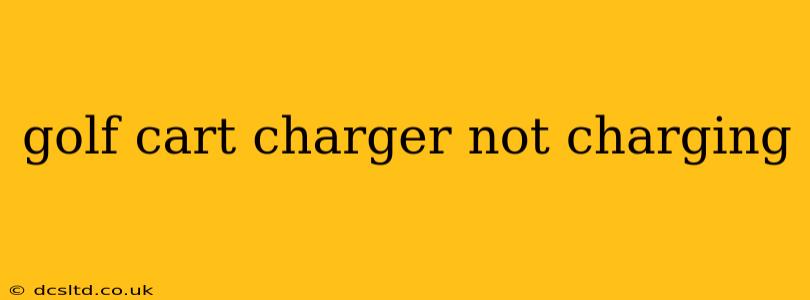Is your golf cart charger refusing to cooperate? A dead battery can quickly derail your golfing plans, leaving you stranded on the green. This comprehensive guide will walk you through troubleshooting why your golf cart charger isn't charging and provide solutions to get you back on the course. We'll cover everything from simple checks to more complex issues, helping you diagnose and fix the problem efficiently.
Why Isn't My Golf Cart Charger Charging?
This is the central question, and the answer often involves a series of interconnected factors. Let's explore the most common causes.
1. Checking the Obvious: Power and Connections
Before diving into complex electrical diagnostics, let's start with the basics.
- Is the charger plugged in properly? This may seem obvious, but a loose connection at either the charger or the golf cart is a frequent culprit. Ensure both ends are securely plugged in.
- Is the outlet working? Test the outlet with another appliance to confirm it's providing power. A faulty outlet could be the root cause.
- Are the cables damaged? Inspect the charger's power cord and the connection cables to the golf cart for any fraying, cuts, or damage. Replace any damaged cables immediately. Damaged cables can lead to poor connections and even electrical hazards.
2. The Charger Itself: Internal Issues
If the power and connections check out, the problem might lie within the charger itself.
- Charger Fan: Does the charger fan run? If not, this could indicate an internal overheating problem. A malfunctioning fan prevents proper heat dissipation, potentially damaging internal components.
- Circuit Breaker: Many chargers have a built-in circuit breaker. Check if the breaker has tripped. If so, reset it and try again. Repeated tripping suggests a more serious underlying issue.
- Internal Components: Unfortunately, diagnosing internal charger problems often requires specialized knowledge and tools. If the charger shows no signs of life, you might need professional repair or replacement.
3. The Golf Cart Battery: The Heart of the Problem
The battery is often the root of charging issues.
- Battery Terminals: Corroded or dirty battery terminals prevent proper electrical contact. Clean the terminals with a wire brush and baking soda solution. Ensure all connections are tight and clean.
- Low Battery Voltage: A completely drained battery may prevent the charger from initiating the charging process. If the battery voltage is extremely low, consider using a trickle charger to gradually bring it back to a safe level.
- Bad Battery Cells: Individual battery cells within the golf cart battery pack may fail. Testing the individual cells can help pinpoint a faulty cell requiring replacement or battery pack replacement. This often requires professional assistance.
- Battery Age: Older batteries are more prone to failure and may not accept a charge efficiently. Consider the age of your battery and whether replacement is necessary.
4. Is the Golf Cart Charger the Right One?
Using the wrong charger can damage both the charger and the battery. Always ensure you're using a charger specifically designed for your golf cart's battery type and voltage. Mismatched chargers can cause overheating, damage, and fire hazards.
5. What if my golf cart charger is still not charging?
If you've checked all the above and your golf cart charger is still refusing to work, it’s time to call in a professional. A qualified golf cart technician can diagnose more complex electrical issues, test the battery, and determine if you need repairs or a replacement charger or battery. Attempting advanced repairs without the proper knowledge and equipment can be dangerous.
By systematically checking these points, you significantly increase your chances of resolving the issue yourself. Remember, safety is paramount – if you're unsure about any step, don't hesitate to consult a professional. Getting back on the course shouldn't involve risking electrical hazards.
